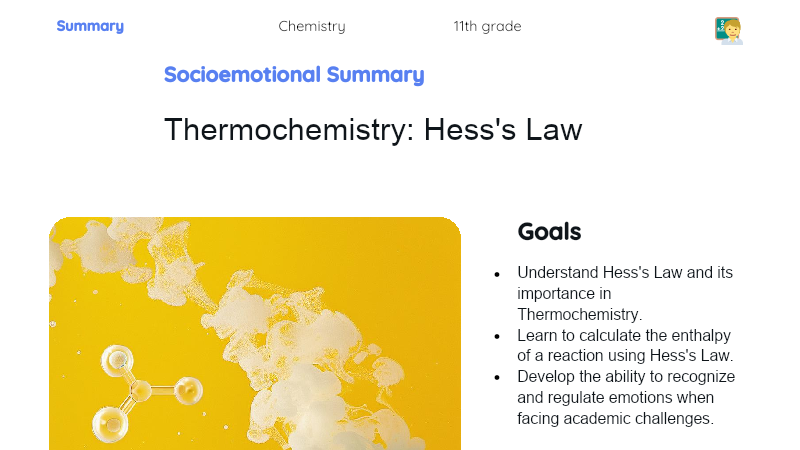Mastering Oxidation Reactions in Organic Chemistry
Objectives
1. Understand the main oxidation reactions in organic compounds.
2. Identify the catalysts involved in oxidation reactions.
3. Explore synthetic routes and products resulting from oxidation reactions.
Contextualization
Oxidation reactions are fundamental in organic chemistry, present in processes as diverse as cellular respiration and fuel combustion. Understanding these reactions is crucial not only for grasping biological and industrial processes but also for the development of new materials and pharmaceuticals. For example, the controlled oxidation of certain molecules can lead to the production of vital medications or the development of new polymers with specific properties.
Relevance of the Theme
Knowledge of oxidation reactions is essential in the job market, especially in chemical and pharmaceutical industries. These processes are utilized in the synthesis of perfumes, plastics, medicines, and even in energy production. Understanding these reactions allows for the development of new products and technologies, directly impacting innovation and efficiency in various fields.
Oxidation Reactions in Organic Compounds
Oxidation reactions in organic compounds involve the loss of electrons by a molecule, atom, or ion. This type of reaction is essential for transforming various chemical substances, including the conversion of alcohols into aldehydes or ketones, and aldehydes into carboxylic acids.
-
Oxidation is the loss of electrons in a chemical reaction.
-
In organic compounds, oxidation often involves the addition of oxygen or the removal of hydrogen.
-
Common examples include the conversion of ethanol into acetaldehyde and acetic acid.
Catalysts in Oxidation Reactions
Catalysts are substances that increase the speed of a chemical reaction without being consumed in the process. In oxidation reactions, catalysts such as transition metals (e.g., platinum, palladium, and copper) are often used to facilitate electron transfer, making the reactions more efficient.
-
Catalysts speed up chemical reactions without being consumed.
-
Transition metals are common in oxidation reactions due to their ability to transfer electrons.
-
Examples of catalysts include platinum, palladium, and copper.
Synthetic Routes and Oxidation Products
Synthetic routes refer to the specific pathways used to synthesize chemical compounds from simpler reagents. In the context of oxidation reactions, these routes can lead to the production of a variety of products, such as carboxylic acids, ketones, and aldehydes, which are fundamental in various industries, including pharmaceuticals and polymers.
-
Synthetic routes are the pathways used to synthesize chemical compounds.
-
Oxidation reactions can produce carboxylic acids, ketones, and aldehydes.
-
These products have applications in industries such as pharmaceuticals and polymers.
Practical Applications
- The oxidation of ethanol to produce acetic acid is an essential industrial process in vinegar manufacturing.
- The synthesis of acetylsalicylic acid (aspirin) involves a crucial oxidation step for the formation of the final product.
- The oxidation of hydrocarbons is a fundamental step in the production of more efficient fuels and lubricants.
Key Terms
-
Oxidation: Process of loss of electrons in a chemical reaction.
-
Catalyst: Substance that increases the speed of a chemical reaction without being consumed.
-
Synthetic Route: Specific pathway used to synthesize chemical compounds from simpler reagents.
Questions
-
How can understanding oxidation reactions influence the development of new medications?
-
In what ways can catalysts make industrial processes more efficient and sustainable?
-
What are the implications of oxidation reactions in the development of new materials and technologies?
Conclusion
To Reflect
Oxidation reactions play a crucial role in both nature and industry. Understanding these reactions allows us to develop vital medications and new materials with unique properties. The ability to identify reagents, products, and catalysts in these reactions is fundamental for any chemist, especially those who wish to work in sectors like pharmaceuticals and materials. Constant practice and application of these concepts in real situations help consolidate knowledge and prepare students for future professional challenges.
Mini Challenge - Exploring the Oxidation of Ethanol
In this challenge, you will model the oxidation of ethanol, identifying the reactants, catalysts, and final products.
- Divide into groups of 3 to 4 people.
- Use Styrofoam balls, toothpicks, molecular modeling kits, or 3D modeling software to build the model.
- Choose the oxidation reaction of ethanol to acetic acid as the focus.
- Identify and model the reactants (ethanol), catalysts (e.g., copper), and final products (acetic acid).
- Present your model to the rest of the class, explaining each step of the reaction.



